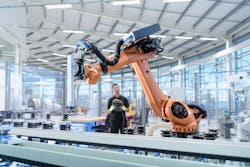Much of the focus around Industrial Internet of Things (IIoT) implementations has targeted discrete devices, such as motors, drives, and controllers, even down to sensors. But what about more complex automation systems that comprise all, or many, of these devices—like robots?
VDMA, the Germany-based Mechanical Engineering Industry Association, is one organization working to develop industry specifications for IIoT robotic applications. In 2017, the association launched the VDMA OPC Robotics initiative because no unified interface standard for robots existed.
Part 1 of the recently released companion specification (which is based on a service-oriented architecture and a client-server model) addresses asset management and condition monitoring. It is now available for download.
The OPC Robotics information model behind the specification reportedly provides vendor-independent access to asset information of all integrated robot systems and their components. It also provides a comparison of the statuses and parameters over many installed systems, which allows for the identification of anomalies.
VDMA says the new specification addresses a complete motion device system. Motion devices can be any existing robot type or even a future robot type, yet to be conceived.
“This release marks a welcome step toward OPC UA-based Industry 4.0 and IIoT interoperability and the broader OPC Foundation’s vision," said Stefan Hoppe, president and executive director of the OPC Foundation. "The collaboration of different groups such as robotics vendors, control manufacturers, automotive end users, integrators, and others has contributed significantly to defining this companion specification for real-world requirements.”
Leaders relevant to this article:


